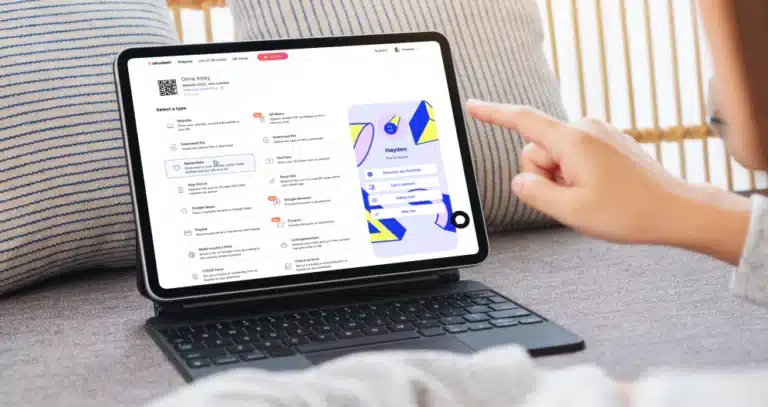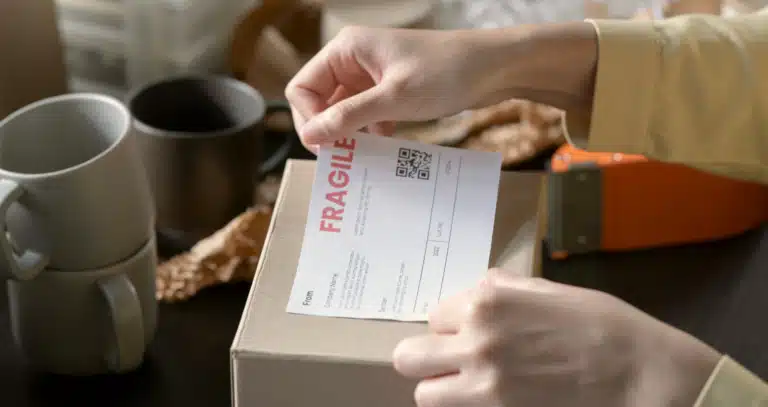Introduction
QR codes have gone a long way since their inception in 1994 as a solution to track car parts. They started as static QR codes that you couldn’t change after generating – like 1D barcodes but with way more space available.
Then, in the late 2000s, they became as a dynamic QR code. Unlike static QR codes, the dynamic ones and their landing page could be updated multiple times, even after being printed.
That’s the single innovation that changed everything and made QR codes unescapable. And believe us; we know a thing or two about dynamic QR codes: QR Code KIT was launched in 2009 as the first dynamic QR code generator ever. We were uQR.me back then.
In this guide, we’re gonna cover everything related to dynamic QRs. From how they work to how to create dynamic QRs, customizing them, tracking their performances, the best tips for successful dynamic QR campaigns, and much more.
You’re in for a great ride. Let’s begin!
What is a QR code?
In case you’ve been on an interplanetary mission during the last 30 years or so, a QR code (Quick Response code) is a type of two-dimensional (2D) barcode that can be read easily by a digital device and stores information as a series of pixels in a square-shaped grid.
QR codes are frequently used to track information about products in a supply chain, and – because many smartphones have built-in QR readers – they are often used in marketing and advertising campaigns.
QR codes can store up to 4,296 alphanumeric or 7,089 numeric characters, and if a high level of error correction is used, up to 30% of the image can be smudged and still be recognized.
QR codes are considered an advancement from older, uni-dimensional barcodes and were approved as an international standard in 2000 by the International Organization for Standardization (ISO).

Static QR codes vs Dynamic QR codes: An in-depth comparison
Dynamic QR codes introduce a level of flexibility and functionality that static QR codes simply cannot match, representing a significant evolution in how QR technology is applied across various industries. Unlike static QR codes, which are permanently tied to the information they encode at creation, dynamic QR codes can be updated to point to new information or resources without the need to reprint or redistribute the QR code itself. This adaptability is particularly crucial for businesses and organizations that need to frequently update their linked content, such as menus, user manuals, event details, or promotional materials.
Key Differences and Advantages
- Editability and Flexibility: Dynamic QR codes are designed for change. They allow for the linked content to be updated or modified at any time, ensuring that the QR code always directs users to the most current information. This is invaluable for dynamic business environments where information changes regularly, eliminating the need to generate a new QR code for each update.
- Trackability and Analytics: One of the most powerful features of dynamic QR codes is their ability to track scans and gather data. This functionality enables businesses to collect insights on user engagement, including the number of scans, geographical location of scans, and the types of devices used. Such data can inform marketing strategies, customer preferences, and even operational decisions, providing a clear advantage over static QR codes, which offer no such analytics.
- Customization and Branding: Dynamic QR codes offer extensive customization options. Businesses can adjust the appearance of their QR codes to match their branding, including colors, logos, and design elements, making the QR codes not only a tool for engagement but also an extension of the brand identity. This level of customization can improve brand recognition and make the QR codes more visually appealing to users, encouraging more scans.
- Enhanced Marketing Features: Beyond simple URL redirection, dynamic QR codes support advanced marketing tactics. Features such as setting scan limits, password protection, and expiration dates enable more controlled and targeted campaigns. For example, a limited-time offer can be promoted through a QR code that expires after the campaign ends, or access to exclusive content can be restricted with password protection.
- Cost-effectiveness and Environmental Sustainability: With the ability to update linked content without reprinting the QR codes, dynamic QR codes are both cost-effective and environmentally friendly. This reduces waste and saves resources, aligning with sustainable business practices. Additionally, the longevity and reusability of dynamic QR codes make them a more economical choice over time compared to static QR codes, which require new prints for each update.
- Greater Engagement and Interaction: The versatility of dynamic QR codes allows for more creative and interactive marketing strategies. They can be used to launch augmented reality experiences, provide personalized content, or even facilitate social media engagement. This level of interaction can enhance the user experience, boost engagement, and foster a stronger connection between the brand and its audience.
The distinction between static and dynamic QR codes lies in their adaptability, functionality, and the value they bring to modern digital strategies. Dynamic QR codes, with their ability to be edited, tracked, and customized, offer a versatile tool for businesses looking to engage with their audience in innovative and effective ways. Whether for marketing, information dissemination, or customer engagement, dynamic QR codes represent a forward-thinking approach to leveraging technology for business growth and user interaction. As the digital landscape continues to evolve, the importance of dynamic QR codes and their potential applications across various sectors is set to increase, making them an indispensable asset for any organization looking to capitalize on the power of QR technology.

How do dynamic QR codes work?
Dynamic QR codes work through redirections. Instead of directly encoding the information required, a dynamic QR code is generated with a unique URL inside: a short URL that, in turn, points to the desired resource or destination. The short URL never changes, while the content it points to can be swapped infinite times.
When users scan a dynamic QR code with their camera app, the scanner doesn’t directly access the end content like with a static QR code. Instead, it communicates with an intermediary server, which then redirects the scanner to the actual content or landing page URL with product details. This indirect process is what allows the content to be changed without altering the QR code itself.
Several benefits arise from this system. Let’s take a quick look at them.
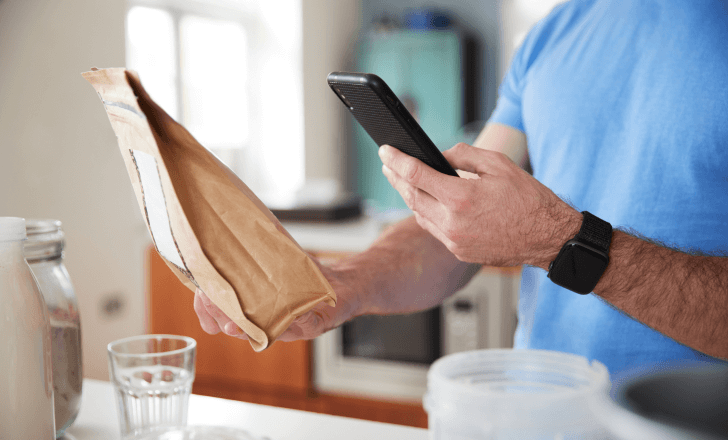
How to make dynamic QRs
Unless you need your QR code to be set in stone forever – and why would you want that? – a dynamic QR code beats a static QR code any day of the week. But how do you create one for your purposes? There are a few simple steps to follow.
1. Select a dynamic QR code generator
This might be the most important thing to do.
We have a detailed guide about how to choose the best QR code generator for your needs. While we warmly recommend taking a look at it for further suggestions and tips, here are the main requirements that a good and reliable dynamic QR code generator should meet.
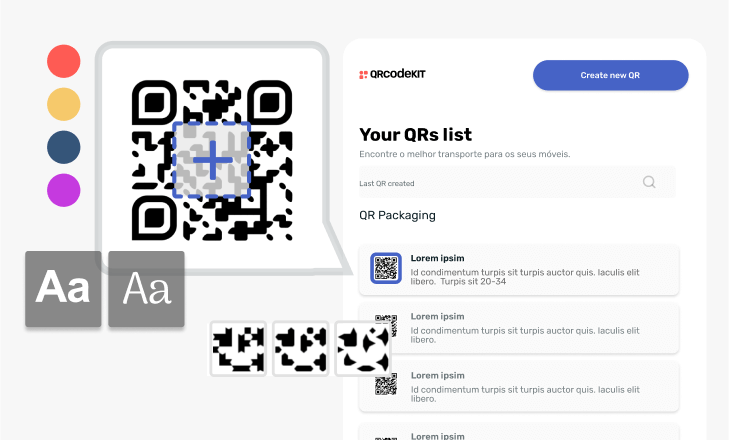
Several dynamic QR types available
QR codes offer the versatility to connect to various digital media. Whether it’s linking to a standard URL, downloading a vCard or a file, showing a YouTube video, or providing directions to places, the options should be plenty and varied. After all, a QR code generator should cater to your needs, not vice versa.
QR codes designed for a specific use case are what we call QR code types. You can have a code type for web pages, a code type for SMS messages, a code type for app downloads, a code type for multiple links, a code for mobile landing pages, multi URL QR codes, smart QR codes, WhatsApp QR codes, etc.
On QR Code KIT, for instance, you have all these QR types that you can choose from:
Website
Connect your QR code to whatever URL destination.
Landing page
Build your own optimized mobile landing pages or pages with rich content easily. No coding is needed.
Social media
The link-in-bio QR code type. A code to connect to all your social platforms and more.
vCard
The digital business card. Scanning the code adds your contact information to the phone’s contacts.
File download
Download any type of file when the QR code is scanned.
CHECK-IN Form
Digitally register people and manage access through the code.
Menu
A code that contains contactless versions of all your menus.
Get messages from leads and customers in your inbox.
Automatically open a WhatsApp conversation when the code is scanned.
Google Maps
Provide directions to reach places through the code.
Google Reviews
Collect feedback from visitors and customers.
YouTube
A code to show videos or connect to entire channels.
PayPal
Collect payments and receive donations with a scan of a QR code.
App store
Send people to the right app store to download your mobile app.
Deep link
Connect visitors with specific landing pages within your mobile app.
Multilingual
Automatically drive visitors to the version of your site in their language.
Coupon
Give out discounts and vouchers easily with a code.
Lead generation
Collect contact info and provide rewards.
If you’re into stats, you can also discover what are the most popular QR code types.
Features to generate custom QR codes with logo
The best QR code generator offers customization features to enhance the visual appeal of your QR code. It allows you to modify the color palette, soften the edges, and even integrate your personal logo at the center of the code.
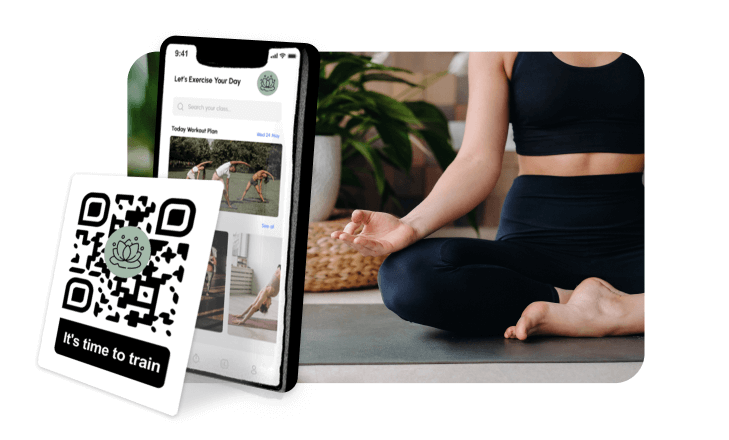
A full range of printing format options
The dynamic QR code generator you select should offer a range of export options, enhancing the versatility of how you utilize your QR codes. The ultimate goal is to have flawless quality when printing QR codes.
You should look for a platform where you can generate dynamic QR codes that you can download in raster format (.jpg, .png) and vector format (.eps, .pdf, .svg).
Analytics tools and reporting
Dynamic QR code statistics are a must-have for your QR code generator of choice.
The gathered data can clearly indicate the frequency, location, and target audience of your QR code scans, among other details. This information can also guide you in assessing if the call-to-action requires adjustments.
Even better if you have the opportunity to connect your QR codes with your Google Analytics account and tag manager for enhanced metrics – exactly like QR Code KIT does.
Dynamic QR code safety and data protection
Ensure the QR code generator you’re evaluating employs a dedicated mechanism to identify both passive and active threats, potentially leveraging external cybersecurity services.
Additionally, it’s crucial for the generator to prioritize data security, such as adhering to GDPR standards – recognized globally for its stringent data protection measures.
For a deeper dive into this subject, refer to our detailed article on safe QR codes.
Team and content management
A top-tier QR code generator provides options for inviting multiple team members to collaborate and categorizing your QR codes into distinct folders, projects, or campaigns (the exact terminology varies by platform).
If you’re juggling several marketing initiatives, each with its unique QR codes, these organizational features of a QR generator can alleviate initial management challenges.
Custom domain option
A solid QR code generator will give you the opportunity to swap the default domain of your QR code short URLs with your own domain.
For instance, instead of qrcodekit.com/qrname, you might have qr.yourdomain.com/qrname.
QR code custom domains are ideal to strengthen the brand and reassure visitors.
Batch and bulk actions
If you plan on generating a large amount of dynamic QRs, you will need this type of feature from a QR generator to create them, edit them, or download them all at once.
Going over 100s of digital business cards to change every website URL individually if your company switches domains is something you want to avoid.
Flexible pricing
The best dynamic QR code solution presents a variety of subscription plans tailored to fit different budgets.
Usually, options range from free subscriptions with essential yet impactful features to comprehensive packages encompassing all the functionalities we’ve mentioned.
A good option to test all these features and more is to register for a 14-day free trial with QR Code KIT.
Highly recommended to cut through the noise and instantly get a comprehensive overview of what a top-tier QR code generator can do.
2. Set up your dynamic QR code in a few steps
Once you’ve made your QR code generator or QR code maker choice, it’s time to finally create your dynamic QR code.
On QR Code KIT, the process is very streamlined and fast:
- Pick the QR code type that fits your needs.
- Fill in the required information. If it’s a Website QR code, you must enter the destination URL. If you are creating a vCard, you’ll have to include your name, email, phone number, job position, etc. If you chose a Google Maps QR, you need to provide the coordinates of the location, and so on. Since you are making a dynamic QR code, you can fix any typos later on or change the content if needed.
- Save your work.
You have finished! You can proceed to customize the appearance of your QR code or directly download it in the desired format – vector is better for printing, and raster is okay to show it on digital media.
Dynamic QR code campaign examples and inspiration
Dynamic QR codes have been at the heart of numerous successful campaigns across different industries. Their versatility and real-time adaptability have made them a favorite tool for marketers.

Here are a few instances that showcase their potential:
Restaurant digital menus
With the rise of contactless services, many restaurants have adopted dynamic QRs to provide digital menus. Customers can scan the code, view the menu on their smartphones, and sometimes even place an order directly.
Event organization and management
A dynamic QR code on an event ticket can link to schedules, maps, or even last-minute changes, ensuring attendees always have updated information.
Retail product information on product packaging
Retailers place QR codes on product packaging. Scanning them can provide detailed product information, reviews, or even a virtual try-on for items like sunglasses or jewelry.
Interactive billboards
Some brands have integrated into their billboard advertisements. Scanning the code could lead to an interactive website, a promotional video, or a special discount.
Healthcare check-ins
Hospitals and clinics utilize dynamic QR codes for patient check-ins, providing a contactless method that can also convey real-time wait times or urgent notifications.
Educational resources
Institutions have embedded QRs in textbooks or study materials. Scanning them can redirect students to supplementary digital resources, videos, or interactive quizzes.
Real estate listings
Realtors use dynamic QR codes on ‘For Sale’ signs. Potential buyers can scan the code to view detailed property listings and virtual tours or even schedule a viewing.
Loyalty programs
Businesses integrate QR codes into their loyalty programs. Customers can scan to check their points, redeem rewards, or access exclusive promotions.
Travel and tourism
Tourist attractions and cities can use dynamic QR codes on informational boards or brochures.
When scanned, tourists could access multilingual guides, videos, and interactive maps to enrich their experience.
Fitness & wellbeing
Gyms and health clubs can place a QR code on exercise machines. Members can scan to watch tutorial videos, log their workouts, or even access personalized training programs.
Museums and art galleries
Art pieces or exhibits can have QR codes beside them. Visitors can scan to delve deeper into the history, artist interviews, or augmented reality experiences related to the artwork.

Public transport
Dynamic QR codes on bus stops or train stations can provide real-time schedule updates, delays, or alternative route suggestions.
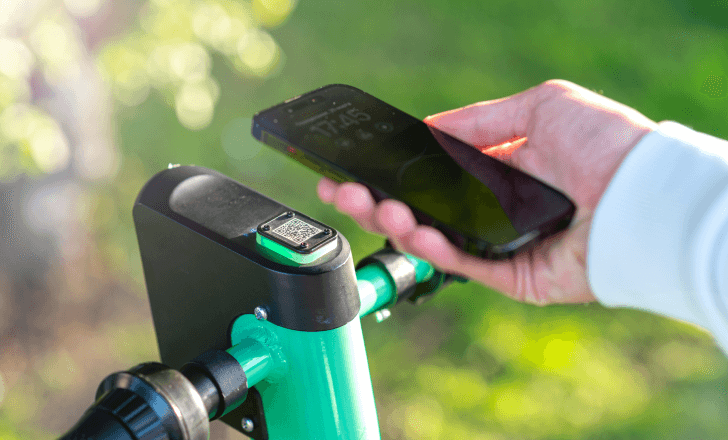
Agriculture & farming
Farmers can use a QR code on produce packaging. Consumers can scan to learn about the farm’s practices, the crop’s journey, or even recipes related to the produce.
Charity & nonprofits
Organizations can integrate QR codes into their fundraising campaigns. Donors can scan to watch testimonial videos, learn more about the cause, or make a direct donation.
Local governments
Dynamic QR codes can be used in public spaces to report issues like broken equipment in parks, potholes, or street light outages. Citizens can scan, report the issue, and later check for updates on its resolution.
Workshops and training
Instructors can provide QR codes on training materials. Participants can scan to access supplementary materials, online resources, or feedback forms post-session.
Again, this is only an initial list: the possibilities are endless with dynamic QRs.
How to run successful marketing campaigns with dynamic QRs
The strategic incorporation of dynamic QR codes can significantly elevate the effectiveness of a QR code marketing campaign.
The real magic, however, lies in how these codes are used. Here’s a deep dive into strategies to harness their full potential.
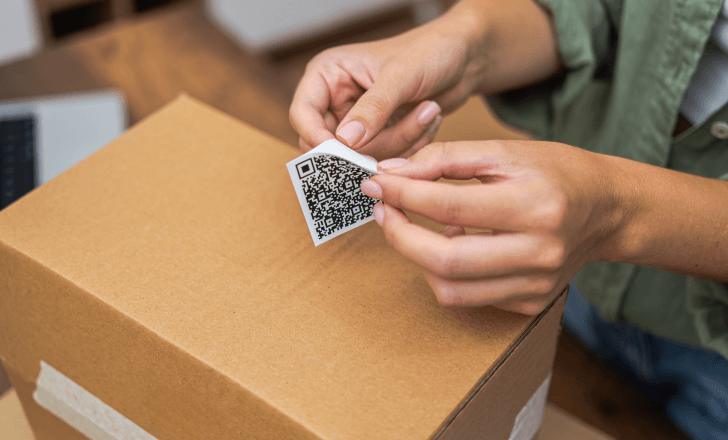
Automate QR code campaigns
Integrate your dynamic codes with marketing automation tools.
For instance, a scanned code at an event booth can automatically trigger a follow-up email with more information about the product or service showcased.
Gather and act on analytics
The data collected from QR code scans can provide insights into user behavior, location, and preferences.
This information is instrumental in refining marketing strategies, segmenting audiences, and delivering targeted content.
Enhance experiential retail
Retailers can use QR codes to create immersive in-store experiences.
For instance, a QR code next to a product could launch an AR experience, allowing customers to visualize how a piece of furniture would look in their home.
Retain and engage customers
Use QR codes in post-purchase scenarios. A code on a product could link to user manuals, tutorial videos, or a platform to register the product and claim a warranty.
This not only enhances user experience but also provides avenues for upselling or cross-selling.
Implement timed promotions
Set expiration dates on your QR codes to run limited-time offers.
Scanning the code post-expiration could redirect users to a sign-up page for future promotions, ensuring you don’t lose out on potential leads.
Feedback and reviews
Place QR codes on receipts or product packages prompting users to provide feedback or write a review.
This not only aids in gathering user sentiments but can also help in online reputation management.
Geotargeting with dynamic QRs
Use different content for QR codes based on the geographical location of the scan.
A brand could provide region-specific offers, information, or even language-specific content – this is easy with QR Code KIT’s multilingual QR code.
Remember, while dynamic QR codes are powerful, their effectiveness is amplified when aligned with a clear marketing strategy, objectives, audience understanding, and creative execution.
Common mistakes to avoid when creating a dynamic QR code campaign
When designing a dynamic QR code campaign, it’s crucial to sidestep typical pitfalls that can hinder the campaign’s effectiveness.
Beware of the following frequently made errors:
- Unclear purpose: Merely placing a QR code without explaining its significance can lead to poor user interaction.
- Wrong QR code type selection: Picking an unsuitable QR code type for your initiative may dampen engagement and outcomes.
- Subpar aesthetics: QR codes with lackluster designs might pose scanning challenges and deter users due to their unappealing look.
- Ambiguous directions: Failing to offer a straightforward call-to-action can impact user interaction and overall results.
- Excessive QR code usage: Bombarding users with too many QR codes might overwhelm them and tarnish your brand’s reputation.
- Foregoing QR code testing: Neglecting to verify the QR code’s functionality can introduce technical hitches and affect its efficacy.
- Neglecting performance analysis: Overlooking the assessment of QR code metrics might lead to overlooked chances to refine the initiative and boost its success.
Overall, avoiding these common mistakes can help businesses and marketers create successful dynamic QR code campaigns that enhance customer engagement and increase brand awareness.
Conclusion
We are entering a new age in the digital era. Augmented experiences are becoming the norm. The world is shapeshifting into a Metaverse. The global pressure for more transparent product information and circularity is increasing.
The need for tools that seamlessly connect our physical and virtual experiences is paramount.
As we look towards the future, the importance of dynamic QR codes, also beyond marketing, is set to amplify. The proliferation of smartphones, coupled with users’ growing comfort with QR code scanning, will only expand the horizons of their applications.
Businesses that can leverage dynamic QR codes more strategically, ensuring they add genuine value to the user experience, will undoubtedly stay ahead of the curve.
From manufacturing to retail, media to education, the applications of dynamic QR codes are diverse and transformative. Their ability to integrate seamlessly with various software platforms, coupled with their user-friendly generation process, makes them an essential tool for companies. With features like real-time content modification, in-depth analytics, and geotargeting, they offer a level of granularity and adaptability that few other solutions can match.
Given this backdrop, choosing the right platform for dynamic codes is essential. QR Code KIT emerges as the natural choice for several compelling reasons:
- It’s the most established dynamic QR code platform, pioneering the field since 2009.
- The platform boasts an impressive array of QR code types, including the unique dynamic email QR, an offering unparalleled in the industry.
- Its robust management utilities, such as multi-user capabilities, teams, batch, and bulk QR creation and management, ensure streamlined operations.
- With top-notch cybersecurity measures, SSO login, and stringent GDPR compliance, QR Code KIT guarantees an airtight safety environment for its users.
Embracing dynamic QR codes is no longer a mere trend but a strategic imperative, and with platforms like QR Code KIT, businesses are well-equipped to leverage their full potential.
Try QR Code KIT for 14 days and unlock the true potential of dynamic codes. Generate QR codes, manage them, and track analytics with advanced tools. No credit card is required.
Get your code now!
